Sugboanons, there’s no need to worry nor panic – for real!

The eruption of Mount Kanlaon caused havoc, not only in Negros Occidental but also in the rest of the Visayan region along with other places nearby places in Southern Luzon, Mindanao, and Palawan. Why? Well, according to the Copernicus Atmosphere Monitoring Service, they spotted that clouds carrying sulfur dioxide (SO₂) had been blown towards the aforementioned areas in the Philippines.

However, following a photo shared by a netizen online showing what seemed to be a hazy afternoon in the Queen City of the South, the Philippine Atmospheric, Geophysical and Astronomical Services Administration (PAGASA) clarified that there’s no need to panic because the sulfur dioxide (SO₂) levels in Cebu’s air is still within breathable and safe ranges.

But, of course, it’s never too early to get to know what would happen in the event that those levels go beyond normal. So, here are some expected aftermath for breathing in the chemical, according to the Centers for Disease Control and Prevention (CDC.gov):
- Can cause eye and skin irritation
- Can result in nose and throat irritation causing nasal mucus, choking, and cough
- Severe exposure can result in bronchospasm, pulmonary edema, pneumonitis, and acute airway obstruction.
- Low exposures can even aggravate asthma and emphysema.
Symptoms of Sulfur Dioxide Poisoning

When one inhales sulfur dioxide, a few symptoms will show up once it hits beyond the normal level such as sore throat, sneezing, wheezing, chest tightness, shortness of breath, and a feeling of suffocation. However, as of this writing, PAGASA hasn’t released any statement regarding the need for wearing facemasks and doing precautionary measures in terms of the sulfur dioxide levels in Cebu.

Nevertheless, always stay on top of the latest information and news, and make sure that you get your data from trusted sources. Stay safe, Sugboanons!

